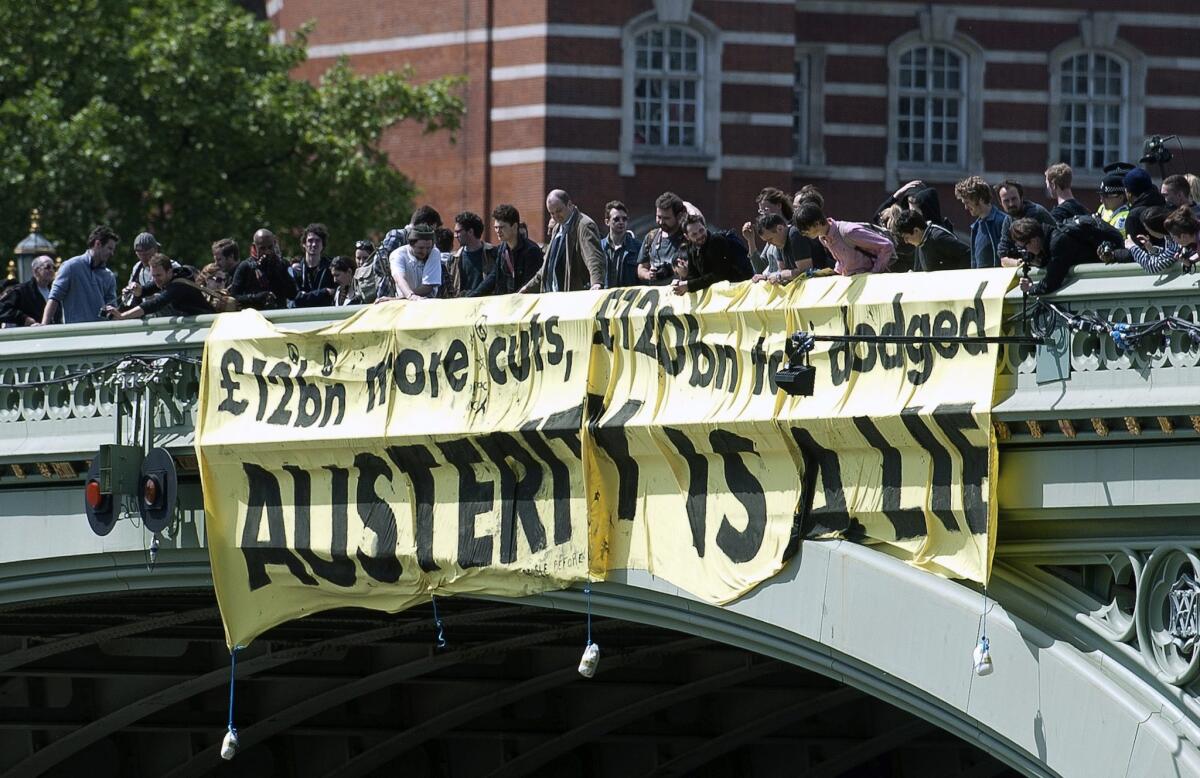The evidence piles up: Austerity poisons economic growth

Demonstrators protest government austerity cuts last month in London.
Why has the post-recession recovery been so slothful, both here in the U.S. and abroad?
The answer has been plain for years: Government leaders pursued policies of austerity, cutting public spending with the fanaticism of moral crusaders. The almost universal result was a stifling of economic growth.
Resistance to public spending hobbled the U.S. recovery and has had even worse effects in Europe, which embraced austerity more. Its impacts are being felt in states such as Kansas and Wisconsin, where tax-cutting and government spending cuts have hobbled public institutions such as the schools while failing to spur job growth. Things have gotten so bad in Louisiana, where budget cuts have Louisiana State University contemplating the equivalent of bankruptcy, that Republican legislators are pleading to be relieved of their earlier no-tax pledges.
The impact on educational programs, unemployment, and physical infrastructure raises moral questions of its own. That’s the view of Nobel economist Amartya Sen, who has spent much of his storied career pondering the moral consequences of economic policies, especially in the developing world.
In an article in The New Statesman, Sen surveys the worldwide landscape of post-crash austerity and comes away distressed at what he sees. One big problem, as Sen sees it, is confusion between the need for institutional reform--of financial systems, government oversight, labor markets, and more--and “an imagined need for austerity.”
He writes, “indiscriminate austerity...does not do anything to change a system while hugely inflicting pain.” It’s as though a fever patient is told he can have an antibiotic, but only if it comes packaged with rat poison: “We were in effect being told that you want economic reform then you must have economic austerity, although there is absolutely no reason whatsoever why the two must be put together.”
Sen draws a strong line from John Maynard Keynes, who was similarly appalled by the allies’ imposition of stringent economic sanctions on the defeated Germany at Versailles after World War I. Kenyes’ concerns about the “economic ruin of a country” (in Sen’s words) were validated during the following two decades, culminating in the rise of Hitler and World War II. Economic punishment of a nation or its people, even when imposed by its own leaders, always bodes ill.
Nowhere are the consequences of austerity more visible today than in Greece, which is battling ferociously with its lenders and its partners in the Eurozone over the unrelenting austerity they’ve imposed on the country--a program that has contributed to negative economic growth every year since 2008 and led to the election of the anti-austerity Syriza party.
“More than half the young people in Greece have never experienced having a job,” Sen writes, bemoaning the squandering of human capital that follows. He could have gone on: As Anand Gopal recently reported in The New Yorker, “average family income has plunged to 2003 levels, and forty percent of Greek children now live below the poverty line.”
Austerity promoters promoted and then played on popular panic over rising government deficits. What they miss, Sen asserts, is that the only reliable method of deficit reduction is rapid economic growth. That comes as no surprise to anyone familiar with economic history.
In the U.S., for instance, the federal deficit peaked in 1943 at nearly 30% of gross domestic product, and remained above 20% through 1945. But the government moved to a surplus by the end of that decade as growth picked up smartly. Almost throughout the 1950s the federal books oscillated between surplus and only a modest deficit. The public federal debt came down sharply too: from a peak of 106% of GDP in 1946 to 46.4% by 1959 and 25% by 1979.
What Sen doesn’t directly address is the historical reality that pressure is always strong from powerful interests to reduce the size of government and the scale of its spending. That’s because the benefits of most government programs tend to flow to the have-nots and the costs to the haves.
But even for the wealthy, this is a shortsighted policy. Crumbling roads and bridges cost business owners dearly in transport costs; underfunded educational systems raise their cost of finding or training qualified workers; poverty and unemployment cause social unrest, which leads to attacks on their property.
In Kansas, Wisconsin, Louisiana and other fanatical tax-cutting and government-shrinking states, the signs are emerging that austerity isn’t even its own reward. High-income taxpayers may feel flush for a while when their rates are being slashed, but when the consequence is shuttered universities, understaffed schools, and unemployment spreading among what should be their customer base, everyone is impoverished. Eventually, the bill comes due.
Keep up to date with the Economy Hub. Follow @hiltzikm on Twitter, see our Facebook page, or email michael.hiltzik@latimes.com.
More to Read
Inside the business of entertainment
The Wide Shot brings you news, analysis and insights on everything from streaming wars to production — and what it all means for the future.
You may occasionally receive promotional content from the Los Angeles Times.







